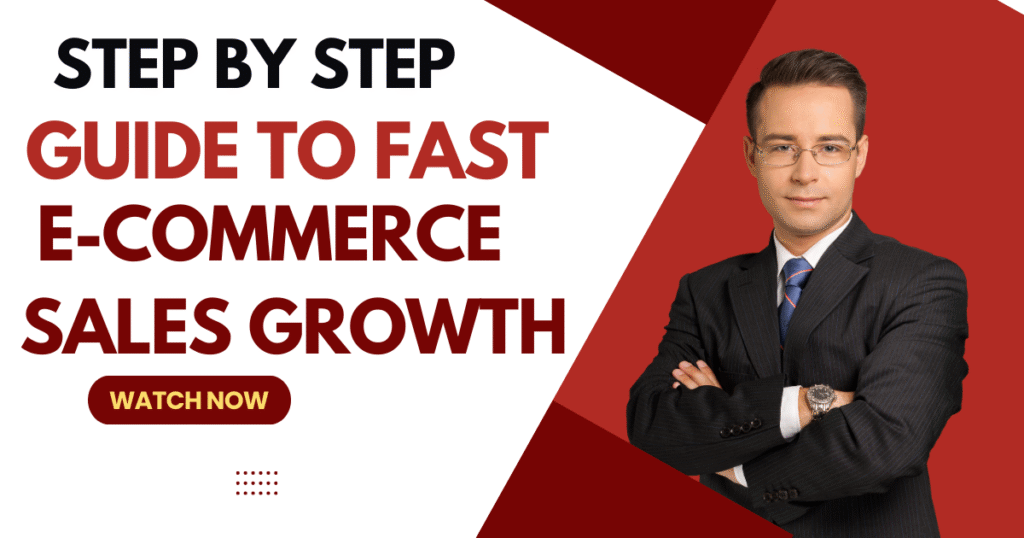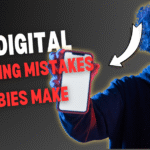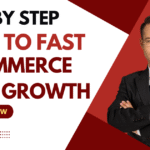In the rapidly changing landscape of online shopping, attaining swift e-commerce sales growth can often feel like pursuing a constantly shifting goal. Nonetheless, with effective strategies, appropriate tools, and a well-defined action plan, achieving this is not only feasible—but also replicable and scalable. Whether you’re opening a new store or attempting to overcome stagnation in sales, this detailed step-by-step guide will outline how you can boost online sales and position your business for long-term success.

Step 1: Enhance Your E-Commerce Website for Conversions
The initial step toward rapid e-commerce growth is to make certain that your website is optimized for conversions. If traffic is flowing but sales are lacking, the issue may reside within your site itself.
Key Focus Areas:
Mobile Optimization: Since over 60% of e-commerce visits originate from mobile devices, it’s essential that your store provides an effortless mobile experience.
Page Speed: Delays in page loading can severely impact conversions. Utilize tools like Google PageSpeed Insights to enhance load performance.
Clear Call-to-Actions (CTAs): Direct users with clear and compelling CTAs such as “Purchase Now” or “Add to Cart.”
Intuitive Navigation: Ensure visitors can easily locate products. Organize items logically and incorporate intelligent search capabilities.
Trust Signals: Showcase customer reviews, testimonials, security badges, and payment protection icons.
Optimizing conversion rates (CRO) should be an ongoing effort rather than a one-time initiative. Employ A/B testing platforms like Optimizely or VWO to perpetually refine user experience on your site.
Step 2: Utilize Effective Product Pages
Your product pages serve as the sales representatives of your online shop. Well-crafted pages can significantly boost e-commerce sales by encouraging customers to finalize their purchases.
Enhance With:
Superior Images & Videos: Incorporate various angles, zoom functionalities, and videos demonstrating the product in action.
Engaging Product Descriptions: Emphasize advantages rather than merely features. Implement bullet points for quick reading.
Urgency Signals: Include countdown timers or indicate low inventory levels to instill FOMO (fear of missing out).
Customer Testimonials: Social validation enhances credibility and increases conversion rates.
Step 3: Attract Targeted Traffic Using Digital Marketing Techniques
Regardless of how exceptional your store may be, it cannot flourish without an influx of visitors. The goal is not merely to increase traffic but rather to attract the right audience—individuals who are ready to make a purchase.
Effective Digital Marketing Channels:
Search Engine Optimization (SEO): Concentrate on long-tail keywords such as “purchase eco-friendly yoga mats” or “top budget wireless headphones for 2025.” Generate blog content that includes buying guides, comparisons, and instructional articles.
Pay-Per-Click (PPC) Advertising: Utilizing Google Ads and Meta Ads (Facebook/Instagram) is effective for driving immediate traffic. Prioritize high-intent keywords and implement retargeting strategies.
Social Media Marketing: Utilize platforms like Instagram, TikTok, and Pinterest for product discovery and enhancing brand engagement.
Influencer Marketing: Collaborate with niche influencers to broaden your reach quickly while establishing credibility.
Email Marketing: Develop an email list and nurture it through welcome series, reminders for cart abandonment, and promotional efforts.
Integrating both organic and paid traffic channels proves to be a robust strategy for boosting e-commerce sales growth.
Step 4: Use Retargeting to Recover Lost Revenue
The Baymard Institute reports that almost 70% of online shopping carts are left behind, representing a significant opportunity for revenue recovery.
Retargeting Strategies and Tools:
Cart Abandonment Emails: Utilize services such as Klaviyo or Mailchimp to send follow-up reminders and provide promotions (e.g., a 10% discount) to entice shoppers back.
Retargeting Ads: Launch retargeting initiatives on platforms like Google and Meta to re-engage users who did not complete their purchases.
Exit-Intent Popups: Implement exit popups featuring offers such as free shipping or discounts to encourage visitors to stay on your site longer.
These strategies can convert previously missed chances into finalized sales, facilitating quicker growth in e-commerce without the need for new customer acquisition.
Step 5: Enhance Sales through Upsells, Cross-Sells, and Boost Average Order Value (AOV)
Often, the key to expansion lies not in increasing the number of items sold but in enhancing purchases per customer.
Methods for Increasing AOV:
Product Bundles: Offer grouped products at a reduced price.
Upsells During Checkout: Propose higher-priced options before finalizing the purchase.
Cross-Selling Opportunities: Suggest relevant accessories or add-ons during or post-checkout.
Free Shipping Incentives: Promote larger orders by providing free shipping on purchases exceeding a specific amount.
Tools such as ReConvert, Bold Upsell, or CartHook can streamline these approaches for effortless execution.
Step 6: Leverage Analytics for Informed Decision-Making
A significant benefit of operating an online business is the ability to access real-time analytics. Without assessing your store’s performance, you’re navigating without direction.
Essential Metrics to Monitor:
– Conversion Rate
– Customer Acquisition Cost (CAC)
– Customer Lifetime Value (CLTV)
– Bounce Rate
– Average Session Duration
– Major Traffic Sources
Utilize tools such as Google Analytics 4, Hotjar (for heatmaps), and Shopify Reports to discover what strategies are effective—and which areas require improvement. Decisions based on data will help boost your e-commerce sales trajectory while lowering risks.
Step 7: Prioritize Customer Retention and Loyalty
Though attracting new customers often takes center stage, true long-term growth in e-commerce comes from retaining existing ones. Repeat buyers tend to spend more and are less costly to market towards.
Cultivate Loyalty Through:
– Outstanding Customer Service: Timely responses, hassle-free returns, and personalized support are crucial.
– Loyalty Programs: Implement points systems, special discounts, or referral incentives.
– Post-Purchase Engagement: Send tailored follow-up messages, solicit feedback through reviews, and offer tracking updates.
– Subscription Services: Where relevant, provide subscriptions that ensure convenience and consistent revenue flow.
Retention goes beyond simply keeping customers; it’s about transforming them into enthusiastic advocates who drive increased online sales through referrals and social media promotion.
Step 8: Optimize Operations and Fulfillment
To maintain rapid growth in e-commerce, your backend processes must align with your front-end sales initiatives.
Enhance:
Inventory Control: Prevent stock shortages and over-selling by utilizing platforms such as TradeGecko or Skubana.
Shipping and Delivery: Partner with dependable carriers while providing various shipping choices. Consider third-party logistics (3PL) if experiencing significant expansion.
Customer Service Tools: Incorporate chatbots, helpdesk solutions (such as Gorgias or Zendesk), and well-structured FAQs to boost customer satisfaction and lighten the support workload.
Streamlined operations enable more time and resources for enhancing marketing efforts and diversifying product offerings.
Step 9: Experiment, Expand, and Automate
The last step involves establishing systems that can accommodate growth without causing burnout. Rapid e-commerce revenue increase is not solely reliant on hard work—it involves strategic automation and scaling successful practices.
Approaches to Scale:
Automate Marketing Efforts: Implement email sequences, retargeting advertisements, and chatbots.
Outsource or Delegate Tasks: Employ virtual assistants or agencies for responsibilities like content production, ad management, or fulfillment services.
Broaden Sales Channels: Distribute products on platforms such as Amazon, Etsy, or Walmart. Investigate international opportunities.
Introduce New Products: Leverage customer insights and trend evaluation to diversify your SKUs effectively.
Continue this cycle—experiment with innovative strategies, invest further in effective ones, and observe how your store transforms into a competitive sales powerhouse.
Concluding Remarks
Rapid growth in e-commerce isn’t merely about pursuing the latest trend. It requires the consistent implementation of reliable strategies, making data-driven optimizations, and consistently focusing on enhancing the customer experience.
By adhering to this comprehensive guide, you will establish a robust base for accelerating your e-commerce sales that is both swift and sustainable. Regardless of whether you are an individual entrepreneur or overseeing an expanding team, these strategies will empower you to scale more intelligently and lead in your market segment.







